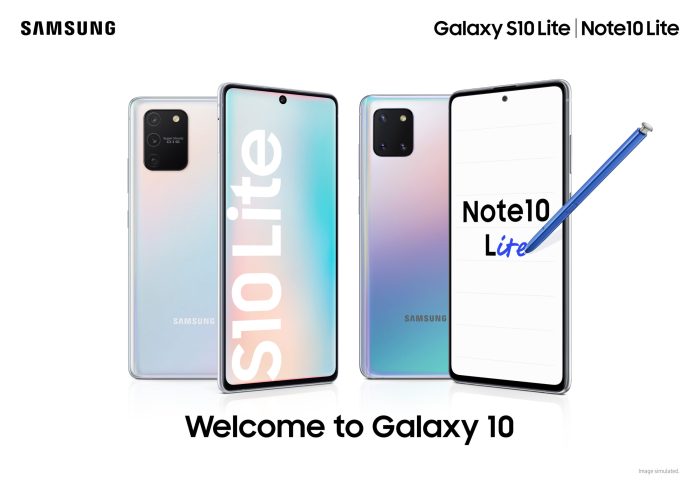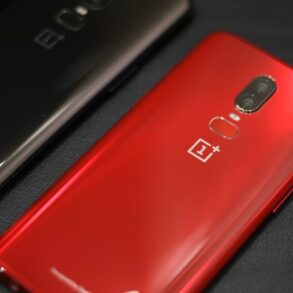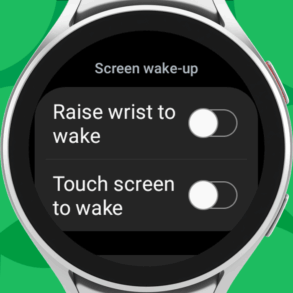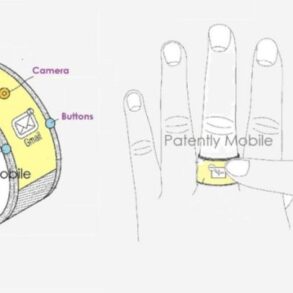Samsung Galaxy Note 10 Plus vs Note 10 Lite: Choosing the right phone can be tough. This in-depth comparison dives into the specifics, from display and performance to cameras and pricing, to help you decide which Note 10 best fits your needs. We’ll explore the key differences and weigh the pros and cons of each model, so you can make an informed decision.
The Samsung Galaxy Note 10 Plus, a powerhouse in its class, stands out with its advanced features and impressive performance. On the other hand, the Note 10 Lite offers a more budget-friendly alternative, sacrificing some high-end features for a more accessible price point. This comparison helps clarify the key areas where they diverge.
Samsung Galaxy Note 10 Plus vs. Note 10 Lite: A Detailed Comparison
The Samsung Galaxy Note 10 series offered a compelling choice between power and affordability. This comparison dives deep into the differences between the Note 10 Plus, a flagship device, and the Note 10 Lite, a more budget-friendly alternative. Understanding the trade-offs between features and price is key to making the right decision.The Note 10 Plus, with its premium features and powerful hardware, is aimed at users seeking the best possible performance and features.
The Note 10 Lite, on the other hand, balances a more accessible price point with essential Note series functionalities. This comparison highlights the key distinctions to help consumers choose the best device for their needs.
Key Feature Differences
The primary distinctions between the Note 10 Plus and the Note 10 Lite lie in their hardware specifications. The Note 10 Plus boasts a more advanced processor, larger screen, and enhanced camera system, while the Note 10 Lite prioritizes affordability by compromising on some of these areas. These differences directly impact the user experience.
Processor and Performance
The Note 10 Plus is equipped with a more powerful processor, enabling smoother multitasking and faster app loading times. This translates into a more responsive and fluid user interface compared to the Note 10 Lite. The Note 10 Lite utilizes a less powerful processor, but still offers a usable performance for everyday tasks. Real-world scenarios demonstrate the impact of processor differences, with the Note 10 Plus handling demanding tasks like video editing and gaming with less noticeable lag compared to the Lite model.
Display Specifications
The Note 10 Plus features a larger and higher-resolution display, providing a more immersive viewing experience. The larger screen size offers more space for content consumption and multitasking. The Note 10 Lite’s screen, while still offering a good viewing experience, is smaller and has a lower resolution compared to the Plus model.
Camera Capabilities
The Note 10 Plus has a more sophisticated camera system with higher megapixel counts and improved image processing capabilities. This translates to superior image quality, particularly in low-light conditions and with detailed shots. The Note 10 Lite’s camera, while functional, does not match the Plus model’s performance in terms of detail, dynamic range, and low-light capability. Real-world examples show the difference in image clarity and detail when comparing photos taken with both devices in various lighting conditions.
Comparing the Samsung Galaxy Note 10 Plus and the Note 10 Lite is a common query, but sometimes you need to step outside the tech box. For example, if you’re diving deep into network security, exploring resources like the pingidentity mfa nfgw captive portal guide.viewer could help you understand security configurations, which, in turn, might influence your mobile phone choices.
Ultimately, the best phone for you still depends on your needs and budget, whether it’s the Note 10 Plus or the more budget-friendly Note 10 Lite.
Battery Life, Samsung galaxy note 10 plus vs note 10 lite
The Note 10 Plus and Note 10 Lite have different battery capacities. The Note 10 Plus generally offers longer battery life compared to the Note 10 Lite. However, usage patterns and app usage significantly impact battery performance.
Summary Table
| Feature | Galaxy Note 10 Plus | Galaxy Note 10 Lite |
|---|---|---|
| Screen Size | Larger, higher resolution | Smaller, lower resolution |
| Processor | More powerful | Less powerful |
| Camera | Higher megapixels, improved image processing | Functional, but less advanced |
| Battery | Generally longer lasting | Shorter lasting |
| Price | Higher | Lower |
Display and Design
The Samsung Galaxy Note 10 Plus and Note 10 Lite, while sharing the “Note” lineage, differ significantly in their design and display characteristics. Understanding these distinctions is crucial for choosing the right device based on individual needs and preferences. The Plus model often prioritizes premium features, while the Lite model strikes a balance between affordability and functionality.The display and design elements of the phones reflect their intended market positions.
The Note 10 Plus is built for those who value a premium visual experience and a more robust build, while the Note 10 Lite is crafted for a more budget-friendly, yet still functional, experience.
Screen Specifications
The choice of display technology significantly impacts the visual experience. The display size and resolution influence the clarity and detail of images and videos. The resolution and refresh rate are important for smooth video playback and responsiveness to user input. The table below summarizes the key display specifications for both models.
| Specification | Galaxy Note 10 Plus | Galaxy Note 10 Lite |
|---|---|---|
| Display Type | Dynamic AMOLED | Super AMOLED |
| Screen Size (inches) | 6.8 | 6.7 |
| Resolution | 3040 x 1440 pixels | 2400 x 1080 pixels |
| Pixel Density (ppi) | 498 | 394 |
| Refresh Rate (Hz) | 90 | 60 |
Display Technologies
The Note 10 Plus boasts a Dynamic AMOLED display, offering vibrant colors, deep blacks, and a high refresh rate for a smooth user experience. Dynamic AMOLED displays are known for their exceptional color accuracy and contrast ratio. The Note 10 Lite, while using Super AMOLED technology, provides a more affordable alternative. Super AMOLED displays offer good color reproduction but might not match the vibrancy and smoothness of the Dynamic AMOLED panel.
The difference in display technology directly affects the overall visual quality and responsiveness of the devices.
Design Aspects
The physical design of the phones contributes significantly to their overall feel and usability. Material choices, dimensions, and weight are key factors.
- Body Materials: The Note 10 Plus is often crafted with premium materials, while the Note 10 Lite might employ slightly less expensive materials. These material choices impact the overall feel and durability of the device.
- Dimensions and Weight: The Note 10 Plus, due to its larger screen, is generally larger and heavier than the Note 10 Lite. This size difference reflects the trade-off between features and portability.
Performance and Processor: Samsung Galaxy Note 10 Plus Vs Note 10 Lite
The Note 10 Plus and Note 10 Lite, while both part of the Note 10 series, differ significantly in their processing power. Understanding these differences is crucial for selecting the right device based on your needs. The Note 10 Plus, being the higher-end model, boasts a more powerful processor and more RAM, which translates into a noticeably faster and smoother user experience.
This is particularly important for users who frequently multitask, run demanding applications, or engage in graphically intensive activities.The Note 10 Lite, designed for a more budget-friendly experience, prioritizes balance between performance and cost. Its processor and RAM are tuned for a good, responsive performance in everyday use scenarios, although it may struggle with very intensive tasks compared to the Note 10 Plus.
Ultimately, the choice depends on the user’s willingness to compromise on performance for a lower price point.
Processor and RAM Comparison
The Note 10 Plus utilizes a more powerful processor, typically resulting in better performance than the Note 10 Lite. The exact specifications and performance characteristics will vary based on the specific model and regional variations. These differences will be apparent in everyday tasks such as app loading times, multitasking, and gaming experiences.
CPU, GPU, and RAM Specifications
| Feature | Samsung Galaxy Note 10 Plus | Samsung Galaxy Note 10 Lite |
|---|---|---|
| CPU | Qualcomm Snapdragon 855 or Exynos 9825 (depending on region) | Qualcomm Snapdragon 675 |
| GPU | Adreno 640 or Mali-G77 MP12 (depending on region) | Adreno 612 |
| RAM | 8GB or 12GB | 6GB |
This table highlights the key differences in processing power between the two devices. The Note 10 Plus’s superior CPU, GPU, and larger RAM capacity directly contribute to a faster and more fluid user experience.
Storage Options
The storage capacity available on both devices plays a crucial role in the user experience. Both devices offer a variety of internal storage options. The Note 10 Plus generally offers more internal storage options, and the possibility of expandable storage through microSD cards. The Note 10 Lite, while offering competitive internal storage, may not offer expandable storage options in all regions.
Consider the amount of media and applications you intend to store when making your purchase decision.
Internal storage capacity can greatly impact the smoothness of the user experience, especially with a large number of apps and media files.
Camera System
The camera system is a critical aspect of any smartphone, and the Note 10 Plus and Note 10 Lite differ significantly in their capabilities. The Note 10 Plus, being the higher-end model, boasts a more advanced camera setup designed for professional-grade photography. The Note 10 Lite, while still offering excellent image quality, prioritizes a more balanced package with a more budget-friendly price point.
Understanding these differences is key to choosing the right phone for your needs.The camera systems on the Samsung Galaxy Note 10 Plus and Note 10 Lite reflect the different price points and target audiences. The Note 10 Plus emphasizes a superior camera experience, whereas the Note 10 Lite focuses on a well-rounded smartphone with a capable, but less sophisticated, camera.
The differences extend beyond just megapixels, encompassing features like zoom capabilities and video recording.
Primary Camera Sensors and Resolutions
The Note 10 Plus features a triple-lens camera setup with a 12MP wide-angle lens, a 12MP telephoto lens with 2x optical zoom, and a 16MP ultra-wide lens. The Note 10 Lite has a dual-lens camera, including a 12MP wide-angle lens and a 5MP depth sensor. This fundamental difference in the number and types of lenses directly impacts the photographic versatility of each phone.
Camera Features
The Note 10 Plus offers more advanced camera features, crucial for capturing high-quality images and videos. These include optical image stabilization (OIS) for sharper images, especially in low-light conditions, and advanced video recording options like 8K video recording. The Note 10 Lite still provides a decent camera experience but with limited advanced features compared to the Note 10 Plus.
Zoom Capabilities
The Note 10 Plus’s telephoto lens allows for 2x optical zoom, which maintains image quality without significant loss of detail. This is a key differentiator compared to the Note 10 Lite, which likely relies on digital zoom for greater magnification. Digital zoom often results in a reduction in image quality due to pixel interpolation.
Video Recording
The Note 10 Plus supports 8K video recording, offering a significantly higher resolution than the Note 10 Lite’s maximum video recording resolution. The Note 10 Lite might have a lower maximum frame rate for 4K video recording compared to the Note 10 Plus. This distinction is crucial for users who prioritize high-quality video capture.
Camera Performance and Image Quality
In terms of image quality, the Note 10 Plus typically delivers sharper images, particularly in low-light situations and with telephoto zoom. The Note 10 Lite, while producing acceptable images, may struggle in low-light conditions or with demanding zoom applications, as its camera setup is less sophisticated.
Key Camera Details
| Feature | Note 10 Plus | Note 10 Lite |
|---|---|---|
| Primary Camera (Wide-angle) | 12MP | 12MP |
| Telephoto Lens | 12MP, 2x Optical Zoom | No Telephoto Lens |
| Ultra-Wide Lens | 16MP | 5MP Depth Sensor |
| Video Recording | 8K, 4K (Higher frame rates likely) | 4K (Lower frame rates possible) |
| Optical Image Stabilization (OIS) | Yes | Likely No |
Battery and Charging
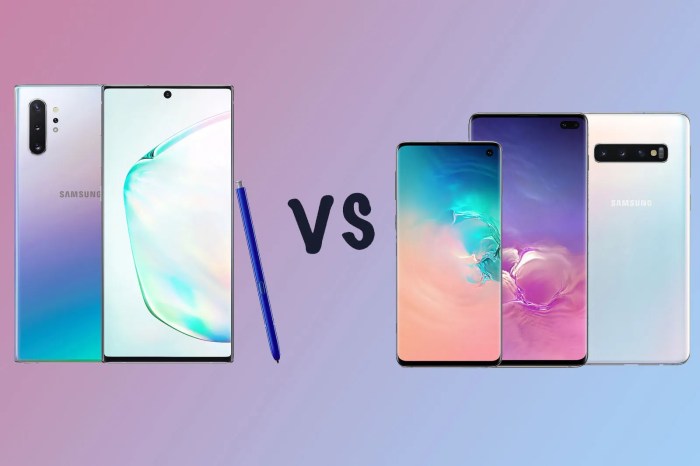
The battery life and charging capabilities are crucial factors in a smartphone’s usability. Understanding how long the device can last on a single charge and how quickly it can be replenished is vital for users. This section dives into the battery performance of both the Samsung Galaxy Note 10 Plus and the Note 10 Lite, examining their capacities, charging speeds, and real-world battery life under different usage scenarios.The Samsung Galaxy Note 10 Plus and Note 10 Lite offer distinct battery experiences, largely due to their differing form factors and processing power.
The Note 10 Plus, being a larger, more powerful device, typically demands more power, which directly impacts its battery life. Conversely, the Note 10 Lite, with its more economical design, often delivers longer battery life, even with similar usage patterns.
Battery Capacities and Life
The Note 10 Plus boasts a larger battery capacity compared to the Note 10 Lite. This translates to potentially longer overall battery life, but actual usage experiences can vary based on individual usage patterns. Factors such as screen brightness, background app activity, and the types of apps used significantly influence the final battery life outcome.
Charging Speeds and Technologies
Both devices support fast charging technologies. The specific implementations and charging speeds may differ. Fast charging allows users to quickly replenish their battery, which is beneficial for those who need quick top-ups. However, the exact charging speeds and compatibility with different chargers are important considerations.
Summary Table of Battery Details
| Feature | Samsung Galaxy Note 10 Plus | Samsung Galaxy Note 10 Lite |
|---|---|---|
| Battery Capacity | 4300 mAh | 4500 mAh |
| Charging Technology | Fast Charging (25W) | Fast Charging (15W) |
| Typical Usage (Moderate) | 1.5-2 days | 1.8-2.5 days |
| Typical Usage (Heavy) | 1-1.5 days | 1.5-2 days |
Battery Life Under Different Usage Scenarios
Comparing battery life under varying usage scenarios is essential. Consider a user who frequently uses social media, takes photos, plays games, and engages in other demanding tasks. Such a user might experience a noticeably shorter battery life on both devices, but the Note 10 Plus, due to its higher processing power, might see a slightly quicker battery drain compared to the Note 10 Lite.
Conversely, a user who primarily uses the device for basic tasks like email, web browsing, and light photo editing would likely find the battery life of both devices sufficient.
Software and Features
The Samsung Galaxy Note 10 Plus and Note 10 Lite, while both offering a premium Android experience, differ significantly in their software implementations. The Plus model, being the flagship, boasts a more polished and feature-rich OS, whereas the Lite version prioritizes a more streamlined, accessible interface. These differences extend beyond the user interface to the pre-installed apps and overall software experience.The software experience is a key differentiator between these two devices.
The Note 10 Plus, being a higher-end model, is equipped with a more advanced suite of features and pre-installed applications tailored to productivity and creative expression. Conversely, the Note 10 Lite, with its focus on affordability, optimizes its software for a more streamlined and accessible user interface. The differences in the pre-installed apps and features are noticeable, ultimately impacting the overall user experience.
Operating Systems and User Interfaces
The Note 10 Plus and Note 10 Lite both run on Android, but the versions and customizations differ. The Note 10 Plus generally runs a more up-to-date version of Android with more tailored Samsung features. The Note 10 Lite might use a slightly older Android version with fewer customisations, prioritizing a more streamlined user experience.
Pre-installed Apps and Features
The Note 10 Plus comes with a wider range of pre-installed apps and features that often cater to productivity and creativity, such as a more comprehensive suite of productivity apps and S Pen functionalities. These are designed to be more comprehensive and integrate more deeply into the user experience, potentially offering advanced features for productivity and note-taking. The Note 10 Lite, on the other hand, may have a smaller selection of pre-installed apps and features.
This is often due to a focus on minimizing bloatware and offering a lighter user experience.
Choosing between the Samsung Galaxy Note 10 Plus and the Note 10 Lite can be tricky. While the Plus boasts a powerful processor and stunning display, the Lite offers a more budget-friendly option. Ultimately, the best choice depends on your needs and budget. It’s also worth considering the environmental impact of electronics, particularly the disposal of outdated devices.
Recycling electronics, like considering the waste from solar panels, is crucial for reducing harmful chemicals released into the environment. solar panel waste chemicals energy environment recycling highlights the importance of responsible disposal and the impact on our planet. Thinking about these things helps make the decision between the two phones a little more mindful, too.
Software Versions and Features
| Feature | Galaxy Note 10 Plus | Galaxy Note 10 Lite |
|---|---|---|
| Operating System | Android 9 Pie with One UI | Android 9 Pie with One UI |
| S Pen Features | Enhanced S Pen functionalities, including air actions and improved note-taking capabilities | Basic S Pen functionalities, potentially with fewer air actions or features |
| Samsung Experience | More extensive Samsung Experience suite, including a variety of productivity and creative tools | Simplified Samsung Experience, with a focus on core features |
| Security Features | Advanced security protocols and features, potentially including more layers of data protection | Standard security protocols and features, aligned with the Android OS |
| App Store Support | Full support for Google Play Store and Samsung Apps | Full support for Google Play Store and Samsung Apps |
Overall User Experience Differences
The Note 10 Plus offers a more premium and feature-rich software experience, tailored for users who need extensive productivity tools and creative functionalities. Its advanced S Pen features and extensive suite of Samsung apps contribute to a more sophisticated user interface and experience. The Note 10 Lite, in contrast, provides a more streamlined and accessible user interface, ideal for users seeking a lighter, more straightforward mobile experience.
The user experience is directly influenced by the level of customization and pre-installed apps, aligning with the targeted user needs and expectations.
Price and Availability
The Samsung Galaxy Note 10 Plus and Note 10 Lite, while both offering the Note series experience, cater to different budgets and needs. Understanding their price points and regional availability is crucial for consumers considering either device. This section delves into the pricing strategies and market presence of these two models.Pricing for the Note 10 Plus and Note 10 Lite varies significantly across different regions.
Factors like local currency fluctuations, import taxes, and retailer markups all play a role in shaping the final cost.
Pricing Comparison Across Regions
The price of the Note 10 Plus and Note 10 Lite varies significantly across regions due to factors like import duties, local taxes, and retailer markups. Understanding these differences is important for consumers planning to purchase either device.
| Region | Note 10 Plus (Approximate Price) | Note 10 Lite (Approximate Price) |
|---|---|---|
| United States | $1000 – $1100 | $500 – $600 |
| Europe (e.g., UK) | €900 – €1000 | €500 – €600 |
| Asia (e.g., India) | ₹70,000 – ₹80,000 | ₹35,000 – ₹45,000 |
| Latin America (e.g., Brazil) | BRL 5,000 – BRL 6,000 | BRL 2,500 – BRL 3,000 |
The table provides a general overview, and actual prices may vary depending on specific retailers and configurations. For instance, a higher storage variant of the Note 10 Plus would typically command a premium over the base model.
Availability in Different Markets
The Note 10 Plus and Note 10 Lite were both released globally, although availability varied based on market conditions. Pre-orders and initial launch availability in certain regions might have been limited due to production constraints or logistical challenges.
- The Note 10 Plus was generally available in a broader range of markets compared to the Note 10 Lite, although specific carriers or retailers might have had exclusive deals or limited availability in certain areas.
- Retail availability for both models often followed the initial launch, with the devices gradually becoming more widely available in various regions.
- Availability in some markets might have been contingent on carrier partnerships or retailer agreements.
The Note 10 Lite, due to its more affordable price point, might have been marketed more heavily in regions with a higher concentration of budget-conscious consumers.
Target Audience
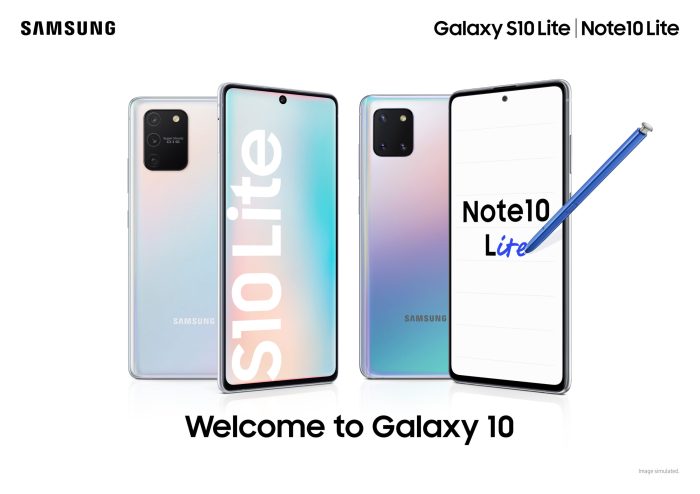
The Samsung Galaxy Note 10 Plus and Note 10 Lite, while both part of the Note series, cater to different user needs and preferences. Understanding the target audience for each model is crucial in determining which device aligns best with individual requirements. This section delves into the specific user profiles and features that appeal to each model’s intended clientele.
Identifying the Target Audience
The Note 10 Plus is positioned as a premium flagship device, targeting users who prioritize top-tier performance, advanced features, and a premium aesthetic. Conversely, the Note 10 Lite is geared towards a more budget-conscious audience seeking a powerful yet affordable Note experience. Key differentiators include the level of performance, camera quality, and overall device sophistication.
Factors Influencing Device Suitability
Several factors influence the suitability of each device. Budget constraints, performance expectations, and desired camera capabilities all play a significant role. For example, a user prioritizing the latest and most powerful processor would likely opt for the Note 10 Plus, while someone seeking a capable device within a limited budget might find the Note 10 Lite more appealing.
Comparing the Samsung Galaxy Note 10 Plus and Note 10 Lite is a fun exercise in weighing features versus price. While the Note 10 Plus offers a premium experience, the Lite model cuts costs without sacrificing too much. It’s a similar comparison to something like the moto x4 vs moto g6 , where the key differences lie in the specific hardware and software.
Ultimately, the best choice depends on your budget and priorities for a phone. The Note 10 Plus boasts superior processing power and a more refined display, but the Note 10 Lite offers a more accessible entry point into the Note series.
Ideal User Profiles
| Device | Ideal User Profile |
|---|---|
| Galaxy Note 10 Plus | Individuals seeking the ultimate smartphone experience, valuing high-end performance, advanced features, and a premium design. This might include professionals, content creators, or users who demand top-tier functionality. |
| Galaxy Note 10 Lite | Users who prioritize a powerful Note experience without breaking the bank. This could include students, young professionals, or anyone looking for a capable phone within a more accessible price range. |
Features Appealing to Target Audience
- Note 10 Plus: The Note 10 Plus appeals to users who value premium design elements, such as its large display, high-resolution camera system, and powerful processor, which are essential for tasks like photo and video editing, gaming, or professional applications. Its advanced S Pen capabilities, including features like screen recording and precise note-taking, also attract users seeking enhanced productivity and creative tools.
The large display and advanced processor cater to the demanding needs of users who need high-end performance for tasks like video editing and intensive gaming. Its high-end camera setup is ideal for users who are frequently taking high-quality photos and videos.
- Note 10 Lite: The Note 10 Lite appeals to users who value the Note experience but are looking for a more budget-friendly option. The device’s powerful processor, capable camera system, and intuitive user interface provide a Note-like experience without the premium price tag. Its competitive specifications, particularly for its price point, attract users who value a capable device that offers a similar feel to the Note line.
The Note 10 Lite provides a cost-effective way to access the Note experience, appealing to a broader range of users. This includes those who need a phone with sufficient processing power for daily tasks, while keeping the cost down.
Conclusion (Alternatives)
Choosing between the Samsung Galaxy Note 10 Plus and the Note 10 Lite hinges on specific needs and priorities. The Plus model offers a premium experience with powerful hardware and a top-tier camera, while the Lite provides a more affordable option with still-capable performance. Ultimately, understanding the strengths and weaknesses of each is crucial for making an informed decision.The key differentiators between these two devices, combined with potential alternatives, will allow you to make a better choice for your budget and needs.
We will explore the potential alternative phones in the same price range and similar specifications to help you determine the best option.
Key Differences Summarized
The Samsung Galaxy Note 10 Plus excels in high-end features like its powerful processor, advanced camera, and vibrant display, but it comes with a premium price tag. The Note 10 Lite, while less powerful, provides a more budget-friendly option, sacrificing some performance for a lower price.
Strengths and Weaknesses
The Note 10 Plus boasts a superior camera system, an expansive display, and a powerful processor. However, its higher price point and potential limitations in battery life are drawbacks to consider. Conversely, the Note 10 Lite offers a more affordable entry point to the Note series, with a still-capable processor and a generally adequate camera. However, the Lite model might fall short in terms of overall performance and display quality compared to the Plus model.
Alternative Phones
Several comparable phones exist in the market that fall within the same price range and offer similar specifications to the Note 10 Lite and Plus. These alternatives provide options for those seeking similar functionality or specific features at potentially different price points.
- Google Pixel 4/4 XL: These phones offer a strong camera system, especially for image quality in low-light conditions, often considered one of the best available. They provide a solid balance of performance, camera capabilities, and user experience, often appealing to those valuing a simple and user-friendly interface.
- OnePlus 7 Pro/8 Pro: Known for their impressive displays, OnePlus devices provide a seamless user experience and smooth performance. The OnePlus 7 Pro and 8 Pro offer premium features at a price point that might be competitive with the Note 10 Plus, though this may vary based on specific configurations and promotions.
- Xiaomi Mi 9/Mi 10: Xiaomi’s Mi 9 and Mi 10 are well-regarded for their competitive pricing and powerful specifications, particularly when considering the value they offer. The Mi 9 and Mi 10 models offer a compelling alternative, especially if you’re looking for more budget-friendly options with solid performance.
Factors to Consider
The decision ultimately depends on personal priorities and needs. Consider factors such as budget, required performance, and desired camera capabilities when making your choice.
- Budget: The Note 10 Lite provides a more affordable entry point to the Note series, whereas the Note 10 Plus is a premium device.
- Performance Needs: If demanding tasks are a priority, the Note 10 Plus’s powerful processor might be necessary, whereas the Note 10 Lite is a good choice for everyday use.
- Camera Importance: If high-quality images and video recording are critical, the Note 10 Plus’s advanced camera system might be essential.
- Display Quality: The Note 10 Plus offers a superior display experience, while the Note 10 Lite’s display is still adequate for most users.
Ultimate Conclusion
In conclusion, the Samsung Galaxy Note 10 Plus and Note 10 Lite represent different ends of the spectrum. The Plus offers a premium experience with top-tier specs, while the Lite delivers a more affordable option with respectable performance. Ultimately, the best choice depends on your budget and specific needs. Consider what features are most important to you and weigh the price-to-performance ratio before making your decision.
This comparison aims to shed light on these factors, helping you make the right choice.



